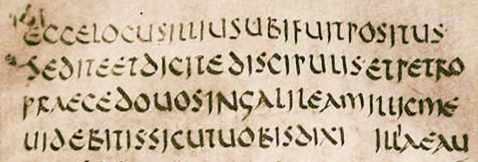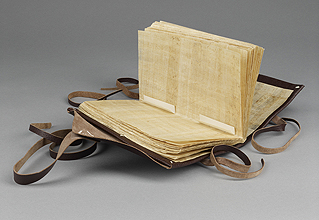
Mark 16:7 as written in Latin in a book from Augustine’s time and place (Codex Bobiensis, North Africa, c. 400).
St Augustine probably never had a Bible – or had even seen one! Back then, in the late 300s and early 400s, Bibles were huge, costly and rare – not something an ordinary person would have till the 1520s, when printing had made them cheap enough for the well-to-do.
What he did have was a book of Psalms, which he took with him everywhere. Most likely he also had a book of the Gospels, a book of the letters of Paul and the book of Genesis. Four separate books.
As you can see from the picture above, books in those days had almost no punctuation, just a grudging space at the end of a sentence. There were no verse numbers either.

What a book looked like in Egypt in the late 300s (based on the Nag Hammadi Library). (Image: Frances Loeb Library)
He called the Bible Scripturae, “writings”, which is what the Bible calls itself in Latin. It was not seen as a single book but as an approved list of holy writings:
Scriptures:
- Old Testament (a term he used)
- Moses: 5 books:
- Genesis,
- Exodus,
- Leviticus,
- Numbers,
- Deuteronomy.
- historical books, not quite in historical order:
- Jesus, son of Nun (Joshua),
- Judges,
- Ruth,
- 1 Kings (1 Samuel),
- 2 Kings (2 Samuel),
- 4 Kings (1 Kings),
- 3 Kings (2 Kings),
- 1 Paralipomenon (1 Chronicles),
- 2 Paralipomenon (2 Chronicles),
- Job,
- Tobias (Tobit),
- Esther,
- Judith,
- 1 Maccabees,
- 2 Maccabees,
- 1 Esdras (Ezra),
- 2 Esdras (Nehemiah).
- Note: Chronicles repeats the history of Kings. Esdras picks up where the Chronicles leave off.
- Prophets:
- David: Psalms,
- Solomon: Proverbs, Song of Songs, Ecclesiastes, Wisdom,
- Sirach: Ecclesiasticus,
- 12 Prophets: Hosea, Joel, Amos, Obadiah, Jonas (Jonah), Micah, Nahum, Habakkuk, Zephaniah, Haggai, Zechariah, Malachi,
- 4 Major Prophets: Isaiah, Jeremiah, Daniel, Ezekiel.
- Moses: 5 books:
- New Testament:
- Gospels: Matthew, Mark, Luke, John,
- Paul: 14 letters: Romans, 1 Corinthians, 2 Corinthians, Galatians, Ephesians, Philippians, 1 Thessalonians, 2 Thessalonians, Colossians, 1 Timothy, 2 Timothy, Titus, Philemon, Hebrews,
- Peter: 2 letters,
- John: 3 letters,
- Jude: 1 letter,
- James: 1 letter,
- Acts of the Apostles,
- Apocalypse of John (Revelation).
Compared to present-day Bibles:
- For Catholics, he is missing Baruch and Lamentations, but they were probably part of Jeremiah. He does quote verses from them.
- For Protestants, he leaves out Lamentations (unless it was part of Jeremiah) and adds Tobit, Judith, 1 and 2 Maccabees, Wisdom, Ecclesiasticus and maybe Baruch.
- For the Eastern Orthodox it is the same as with Catholics but he is also missing a book of Esdras, a book of Maccabees, and a Psalm.
His order is somewhat different too.
The Latin translation: he did not use the Vulgate till age 49. Before then he used a bad translation made by half-educated Christian missionaries sent to his part of Africa some 200 year before. The Latin was shockingly bad, yet there were Christians who modelled their speech on it! At age 19, with his fancy education, it turned him off from Christianity.
Nor was that Latin Bible even translated from the Hebrew Old Testament or the best copies of the Greek New Testament. Instead:
- The Old Testament, like with Eastern Orthodox Bibles today, was translated from the Septuagint, the Greek translation of the Hebrew Bible made by the Library of Alexandria.
- The New Testament was translated from Western text-types, “improved” copies of the Greek New Testament that featured some paraphrasing and added material.
– Abagond, 2016.
Sources:
- Frances Loeb Library at Harvard;
- “Augustine” (2005) by James J. O’Donnell;
- “In the Beginning” (2001) by Alister McGrath;
- “Augustine: A Very Short Introduction” (1986) by Henry Chadwick;
- Book 3 of “Confessions” (400) by Augustine;
- Book 2 of “De doctrina christiana” (397) by Augustine.
See also:
- Hugh Houghton’s scholarly reconstruction of the Gospel of John based on Augustine’s quotations – thesis, PDF, 666 pages, including background, methodology, etc.
- Augustine
- Latin
- Bible
- Vulgate
- Septuagint
- English Bible translations
- New Testament canon – how the New Testament came to be.
- Library of Alexandria
- Nag Hammadi Library
- printing
- Roman alphabet
636

Thank you for this interesting information.
LikeLike
It never occurred to me that Augestine didn’t have a complete Bible and what he had was poorly translated. Yet his ideas helped mold what modern Christianity is today.
LikeLike
If you read Augustine in English translation, he mostly uses the King James Bible, which, of course, did not exist back then!
LikeLike